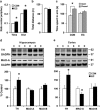Plant-derived flavanol (-)epicatechin mitigates anxiety in association with elevated hippocampal monoamine and BDNF levels, but does not influence pattern separation in mice
- PMID: 25562843
- PMCID: PMC4312829
- DOI: 10.1038/tp.2014.135
Plant-derived flavanol (-)epicatechin mitigates anxiety in association with elevated hippocampal monoamine and BDNF levels, but does not influence pattern separation in mice
Abstract
Flavanols found in natural products such as cocoa and green tea elicit structural and biochemical changes in the hippocampus, a brain area important for mood and cognition. Here, we evaluated the outcome of daily consumption of the flavanol (-)epicatechin (4 mg per day in water) by adult male C57BL/6 mice on measures of anxiety in the elevated plus maze (EPM) and open field (OF). Furthermore, pattern separation, the ability to distinguish between closely spaced identical stimuli, considered to be mediated by the hippocampal dentate gyrus (DG), was tested using the touchscreen. To investigate mechanisms through which (-)epicatechin may exert its effects, mice were injected with bromodeoxyuridine (50 mg kg(-1)) to evaluate adult hippocampal neurogenesis. In addition, monoaminergic and neurotrophin signaling pathway proteins were measured in tissue derived from subject cortices and hippocampi. Flavanol consumption reduced anxiety in the OF and EPM. Elevated hippocampal and cortical tyrosine hydroxylase, downregulated cortical monoamine oxidase-A levels, as well as increased hippocampal brain-derived neurotrophic factor (BDNF) and pro-BDNF support the flavanol's anxiolytic effects. In addition, elevated pAkt in hippocampus and cortex was observed. (-)Epicatechin ingestion did not facilitate touchscreen performance or DG neurogenesis, suggesting a non-neurogenic mechanism. The concurrent modulation of complementary neurotrophic and monoaminergic signaling pathways may contribute to beneficial mood-modulating effects of this flavanol.
Figures



Similar articles
-
Xiaochaihutang attenuates depressive/anxiety-like behaviors of social isolation-reared mice by regulating monoaminergic system, neurogenesis and BDNF expression.J Ethnopharmacol. 2017 Aug 17;208:94-104. doi: 10.1016/j.jep.2017.07.005. Epub 2017 Jul 5. J Ethnopharmacol. 2017. PMID: 28687505
-
Melatonin ameliorates cuprizone-induced reduction of hippocampal neurogenesis, brain-derived neurotrophic factor, and phosphorylation of cyclic AMP response element-binding protein in the mouse dentate gyrus.Brain Behav. 2019 Sep;9(9):e01388. doi: 10.1002/brb3.1388. Epub 2019 Aug 20. Brain Behav. 2019. PMID: 31429533 Free PMC article.
-
Behavioral and serotonergic consequences of decreasing or increasing hippocampus brain-derived neurotrophic factor protein levels in mice.Neuropharmacology. 2008 Nov;55(6):1006-14. doi: 10.1016/j.neuropharm.2008.08.001. Epub 2008 Aug 12. Neuropharmacology. 2008. PMID: 18761360 Review.
-
Effects of sub-acute and sub-chronic inhalation of 1-bromopropane on neurogenesis in adult rats.Toxicology. 2013 Feb 8;304:76-82. doi: 10.1016/j.tox.2012.12.009. Epub 2012 Dec 21. Toxicology. 2013. PMID: 23266320
-
BDNF isoforms: a round trip ticket between neurogenesis and serotonin?J Neurochem. 2016 Jul;138(2):204-21. doi: 10.1111/jnc.13658. Epub 2016 May 31. J Neurochem. 2016. PMID: 27167299 Review.
Cited by
-
An insight into the neuroprotective and anti-neuroinflammatory effects and mechanisms of Moringa oleifera.Front Pharmacol. 2023 Jan 5;13:1035220. doi: 10.3389/fphar.2022.1035220. eCollection 2022. Front Pharmacol. 2023. PMID: 36686668 Free PMC article. Review.
-
Neurogenic Traditional Chinese Medicine as a Promising Strategy for the Treatment of Alzheimer's Disease.Int J Mol Sci. 2017 Jan 28;18(2):272. doi: 10.3390/ijms18020272. Int J Mol Sci. 2017. PMID: 28134846 Free PMC article. Review.
-
Discovery of Herbal Remedies and Key Components for Major Depressive Disorder Through Biased Random Walk Analysis on a Multiscale Network.Int J Mol Sci. 2025 Feb 28;26(5):2162. doi: 10.3390/ijms26052162. Int J Mol Sci. 2025. PMID: 40076790 Free PMC article.
-
Effect of Alkaloid Extract from African Jointfir (Gnetum africanum) Leaves on Manganese-Induced Toxicity in Drosophila melanogaster.Oxid Med Cell Longev. 2018 Dec 30;2018:8952646. doi: 10.1155/2018/8952646. eCollection 2018. Oxid Med Cell Longev. 2018. PMID: 30693067 Free PMC article.
-
Neuroprotective Natural Products' Regulatory Effects on Depression via Gut-Brain Axis Targeting Tryptophan.Nutrients. 2022 Aug 10;14(16):3270. doi: 10.3390/nu14163270. Nutrients. 2022. PMID: 36014776 Free PMC article. Review.
References
-
- Joseph JA, Shukitt-Hale B, Willis LM. Grape juice, berries, and walnuts affect brain aging and behavior. J Nutr. 2009;139:1813S–1817S. - PubMed
-
- Spencer JP. The impact of fruit flavonoids on memory and cognition. Brit J Nutr. 2010;104:S40–S47. - PubMed
-
- Reznichenko L, Amit T, Youdim MB, Mandel S. Green tea polyphenol (−) epigallocatechin-3-gallate induces neurorescue of long-term serum deprived serum deprived PC12 cells and promotes neurite outgrowth. J Neurochem. 2005;93:1157–1167. - PubMed
Publication types
MeSH terms
Substances
Grants and funding
LinkOut - more resources
Full Text Sources
Other Literature Sources
Medical
Research Materials

